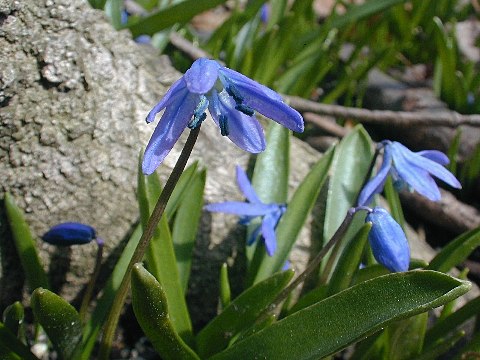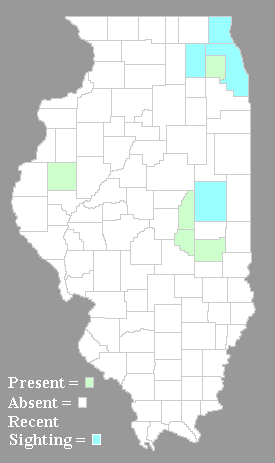Description: This perennial wildflower consists of a rosette of semi-erect basal leaves about 6" tall or less. At maturity, these leaves are about 5" long and ¾" across. They are linear-oblong, hairless, shiny green, and smooth along the margins, tapering to a blunt point. Usually, each mature leaf rolls upward from the middle toward the margins along its length. One or more flowering stalks are produced from the center of the rosette. These narrow stalks are up to 6" long, leafless, and often purplish green. Each stalk curves downward at its apex and bears a single nodding flower.

The flowers are
about 1" across, consisting of 6 blue tepals, 6 stamens with blue
anthers, and a green pistil with an undivided style. Each tepal is
oblong-linear and has a single vein of dark blue running along its
length. The blooming period occurs from early to mid-spring and lasts
about 2-3 weeks. There is a strong floral fragrance that is quite
pleasant. The seed capsules are oval-orbicular in shape and bumpy
across the surface. They are initially green, but eventually turn
brown, each one containing several seeds. The root system consists of a
small bulb with secondary roots. This plant often forms vegetative
colonies by offsets.
Cultivation:
The preference is partial sun during the spring, mesic conditions, and
a fertile loamy soil with an abundance of organic material. Siberian
Squill adapts well to deciduous woodlands and naturalizes easily. It
also adapts to sunny grassy areas. The foliage dies down by early
summer. At wet locations, crown rot can become a problem. Different
horticultural varieties of this plant exists, including one with white
flowers.

Range & Habitat:
The non-native Siberian Squill is an uncommon plant that occurs in only
a few counties
in Illinois, primarily in the east-central region of the state. It was
introduced into the United States from Eurasia as a horticultural plant
because of its attractive flowers. Habitats include disturbed grassy
areas, areas along
railroads, flower gardens, and deciduous woodlands. While it may occur
in sunny sites, this is primarily a spring-blooming plant of deciduous
woodlands. The small dormant bulbs have the capacity to survive major
earth-moving operations, and may reestablish themselves wherever the
soil is dumped. Siberian Squill is more robust and more likely to
naturalize than many other spring-blooming flowers from bulbs, but it
is not particularly aggressive. At a favorable site, a few plants may
form a sizeable colony after several decades.
Faunal Associations:
The fragrant flowers are very attractive to various kinds of bees. The
foliage and seed capsules are avoided by mammalian herbivores because
they contain pyrrolizidine and other toxic alkaloids. Except for the
attractiveness of the flowers to bees, the ecological value of this
wildflower to fauna is low.
Photographic Location:
Busey Woods in Urbana, Illinois, where there are about 1-2 small
colonies
of plants that have persisted for about 40-50 years. They occur in an
area where the remnants of a downtown area were dumped in the woodlands
in preparation for the development of a new mall.
Comments:
This is one of the first wildflowers to bloom in deciduous woodlands.
The flowers are attractive in appearance and they have a lovely
fragrance. Siberian Squill doesn't conform to the popular stereotype of
a 'weed.' However, because this introduced plant that has the potential
to displace native plants, many ecologists would regard it as a weedy
plant for this reason, regardless of its attractiveness and ephemeral
nature. Siberian Squill has a distinctive appearance and is easy to
identify. It differs from Camassia spp. (Wild
Hyacinths) in having stiffer leaves and by producing only a single
nodding flower on each stalk. Some varieties of Siberian Squill may
produce racemes of 2-3 flowers on some stalks, but such racemes are
shorter and have fewer flowers than the racemes of Wild Hyacinths.
While the tepals of Siberian Squill are single-veined, the tepals of
Wild Hyacinths usually have 3 veins and their flowers don't nod
downward.